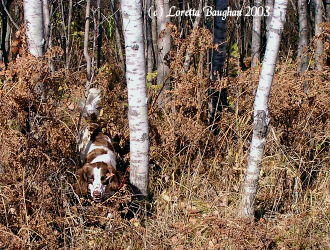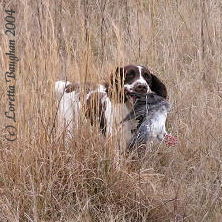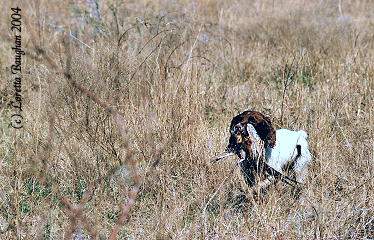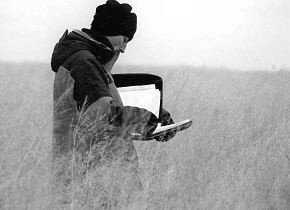  Hi there again folks!
Loretta hasn't fired me, yet. I suspect she is too busy with her litter of puppies - so she forgot about me!
When last we spoke, I was in the middle of answering questions relating to my first article and
various issues that come up in field trials. As a trailer on the last
article, I mentioned that I would finish up with the original questions in
this article and then discuss electric collar training. Apparently I hit a
nerve with folks. Many people have expressed interest in an electric collar
discussion. I was going to skip the last of the original questions and head
straight to the collar stuff, but I'm afraid I might be opening a can of
worms with that so we may not get back to the original questions for a
while. That isn't fair to the folks who asked them, so I will use this
article to finish off the questions and then delve into electric collars in the
next issue. Suffice it to say for now that I do use electric collars - but I
also feel they are the single greatest threat to our breed at the moment.
(If that didn't interest you enough to read the next issue, then Loretta
really does need to fire me!)
"Give dogs the chance to shine whenever possible."
So, last time we talked about puppy stakes, fun trials, hunt tests, and dogs
with flush issues. We stopped at heavy cover trials. The next question asked
was: "How is a judge to do his job at a trial with cover the keeps the dog
hidden from sight?" This is a great question that is tough to answer
completely. It brings up a fundamental difference in philosophies regarding
field trials and how they relate to the hunting we do with our dogs. First
off, let us answer the question then discuss implications of the question.
In simplest terms, when judging in heavy cover I like the dogs that I can see the
best! A dog that frequently checks in with its handler typically runs
tighter in real heavy cover. The dogs that do well under me are the ones
that hunt the objectives on the course and frequently check in for
direction. I want them running downwind of major objectives such as bushes
or clumps of grass. I want the dog smashing through the cover showing
boldness, stamina, and desire. And most importantly, I want them keeping
track of their handler while they are doing it all.
Many field trials are run in very light cover where the dogs and handlers
can always see each other. A lot of whistle is used to keep the dog working
back to the handler. When these same dogs get isolated from their handler in
heavier cover, they often tend to start hunting on their own. The handler
doesn't know when to blow the whistle because they can't see the dog,
meanwhile the dog is off doing its own thing. The series gets completely
messed up and somehow it is the fault of the field trial committee who ran
the trial in the heavy cover. That seems rather silly to me because I often
hunt in places where I can't see my dog. Many, actually most field trailers
can't make that same statement. They don't hunt, they just play the field
trial game and prefer to have lighter cover where they can see their dogs.
This lighter cover works great for the pen raised birds that are being used.
This is the difference in philosophies between field trial folks. It says in
the "blue book" (book of field trial guidelines) that the reason we field
trial is to find the best hunting dog. Some folks take that quite literally
and look for the best hunting dog. Other folks don't. They are looking for
the best field trial dog - which isn't always the same thing. We will get into
this much deeper in our electric collar discussion, but the bottom line is
some trailers hunt and other don't. Those that hunt like running the trials
in cover where one might actually find a bird in the wild. Those that don't
hunt like running the trials in very even cover as that is more fair to each
individual dog. Each side has a good argument but in the end we sell most
of our puppies to hunters, not field trailers.
"As a judge, it is your job to balance bird finding with control, using the weekends conditions as the scale."
Now, while running in heavy cover, a judge should make certain allowances. A
dog that checks in frequently with the handler will not do so when on game.
It isn't necessarily the dog's fault if he trails a bird onto his bracemate's
course and flushes it on the wrong side of the flag line. Also, birds can
come from anywhere. In heavy cover, they can be running all over the place.
I am typically very slow to throw out a dog for a poached bird (one flushed on
the bracemate's course) or a passed bird, when in that situation. As a judge, I
am very slow to call a passed bird in light cover. In real heavy cover, I am
very, very slow to do it. Common sense is the key here. Negative judges are
disaster in this situation. When judging this sort of trial, you must not
look for ways to throw dogs out. Instead, you need to be looking for ways to
mark dogs up. Look for the good things they did and think about how you
would like to work with that dog if you were hunting instead of field
trialing.
In the same vein is retrieves. Many field trial folks do not send for long
retrieves. One long time pro once told me that he believes that dogs shouldn't
even be sent if the wing gun on the other course shoots a bird, as that
isn't fair since most of the dogs don't get that opportunity. I feel that
life isn't fair and one has to deal with it.
I send for most reasonable retrieves. If I have the time on a given weekend, I send for many
unreasonable retrieves, too! I'm not looking to throw dogs out on a failed
retrieve, but to mark them up on a job well done. When I had time while
judging the National, I sent on many long falls. I was quick to tell the
handlers that they were welcome to handle the situation any way they wanted
to - I just wanted the bird. I didn't expect the dogs to actually make the
mark on some of those falls, but I did expect the handler to be able to get
the dog into the area of the fall and get me the bird. I typically tell
folks to: "Do whatever you want, just get me the bird." That means exactly
what it says. I will judge you accordingly. If you are able to direct your
dog with a couple of long "get backs" and "overs" I will very much like it.
If you need to walk out and point at the bird before your dog can find it
you still might not be out, but I will certainly judge you lower on it.
When hunting, I have never left a shot bird in the field because I thought it
was too far away to retrieve. I believe that this practice in field trials
looks very bad to folks who are visiting for the day. I have to believe
that any folks trying to decide whether our game is ethical or not would
certainly not be swayed to our side of the fence after seeing several birds
left to rot in the field because they were too far for a dog to retrieve.
Also, when judging these long falls, you are free to change your mind. I have
sent for some wing-tipped roosters that were not really that far away. I
wanted to give the dogs the opportunity to do it. In the end, a couple of
times I decided that the dog really had little chance of completing the
retrieve. So even though they didn't come up with the bird, I forgave them for
it and we went back onto the course and carried on. Give dogs the chance to
shine whenever possible.
Lastly, is the question of running at field trials - specifically running
after your dog while he is on game. When taking a runner, often handlers
will run after their dog with guns and judges in tow. It says quite
specifically in the blue book that this is not allowed. What one is supposed
to do is stop your dog and catch up to him with a brisk walk. Or, if the
bird is running up the middle of the course, call your dog off the bird and
quarter up the course.
In the real world things are a bit more indefinite.
Often times scenting isn't very good, especially ground scenting in the
light cover where we run many of our trials. The time it takes to stop your
dog and catch up could mean the difference between finding a bird and not
finding a bird. There is no correct answer here - it depends on the
situation. If scenting is great, move quickly and keep stopping your dog
until you catch up with the bird. If scenting is awful, let your dog go until
it is just out of range. If you just can't keep up, stop him then and catch
up. In these conditions I will often move pretty fast to keep up with my dog
so that I can give him every chance to find that bird. When conditions are
average, show your dog off as best as possible. Don't stop your dog four
times and then lose the bird, but don't run after the dog, either. If your
dog won't stop while working game, then go ahead and run after him, hoping
the judge won't figure out what you are doing. Many judges are more
impressed with bird work and less impressed with control so you may be
surprised at what you can get away with. As a judge, it is your job to
balance bird finding with control, using the weekends conditions as the
scale.
Runners up the middle of the course are really tough. One is supposed to be
able to call the dog off the runner and quarter up the course. Some judges
actually want to see that, others do not. When in this situation, it is
normally best to stop your dog, explain that you think your dog is taking a
runner up the course, and ask the judge how he would like you to handle it.
This is normally the only way to insure that you will give the judge what
they want. That being said, often judges are surprised in that situation. I
did that at a National a couple of years ago and actually had the judge tell
me to "do whatever I think is best." What I thought was best was to do
whatever the judge preferred for me to do in that situation so that answer
was of little help to me. What I did do was get lucky, deciding to quarter
my dog but having the bird run diagonally off the course after a flag so we
got to take the runner off to the side. As a judge, if your handler is not
handling this in the manner in which you would like it is not inappropriate
to tell them before they get into too much trouble. IF you want the dog to
cover the course instead of taking the runner up the middle of it, stop the
handler who is running up the course and explain to him that he is not
helping himself.
All right, that is most of the non-electric collar related questions. Next
issue, we are on to the shocking truth of spaniel training.
Don't forget the liver treats,
Jason
|



